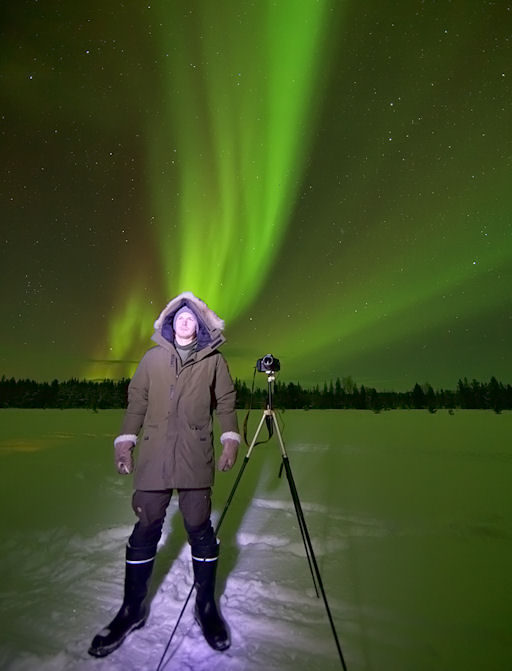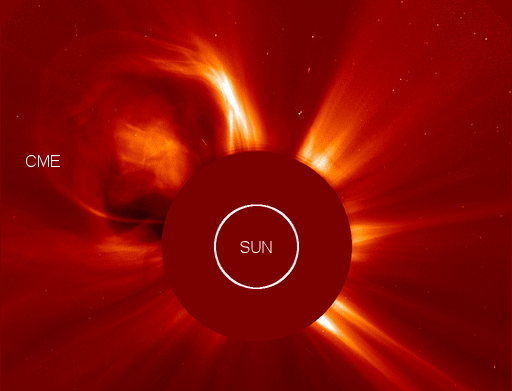CHANCE OF AURORAS: A coronal mass ejection (CME) heading mainly for Venus might deliver a glancing blow to our planet, too, on Jan. 19th. High-latitude sky watchers should be alert for auroras when the cloud arrives.
In Finland, the Northern Lights are already shining. Aurora tour guide Andy Keen took this picture last night in the Municipality of Inari:
"
We didn't need head-torches as the forest was illuminated by the Aurora dancing above our heads," describes Keen. "For over two and a half hours we witnessed one of the best light shows that I've ever observed in over 5000 hours of 'chasing' the auroras. Ribbons, curtains, mini spirals, bursts - you name it and we had it."
"Some of our group were so amazed by what we were witnessing that they simply lay on their backs in the snow and soaked it all up. Others ran around making noises like over excitable school children - myself included. It was absolutely mind-blowing to say the least. If this is a sign of things to come as Solar Maximum approaches, then all I can say is that we're all in for a real treat over the coming months and years." Aurora alerts: text, voice.
VENUS-DIRECTED CME: Sunspot complex 1401-1402 erupted yesterday, Jan. 16th at approximately 0400 UT, producing a C6-class solar flare (SDO movie) and a bright coronal mass ejection. SOHO recorded the expanding cloud:
According to a forecast track prepared by analysts at the Goddard Space Weather Lab, this CME will hit Venus during the late hours of Jan. 18th. Because Venus has no global magnetic field to protect it, the impact will erode a small amount of atmosphere from the planet's cloudtops. There's no cause for concern, however, because Venus's massive atmosphere will scarcely notice the loss.
The same analysis shows that the CME might deliver a glancing blow to Earth's magnetic field around 1200 UT on Jan. 19th. The impact could cause geomagnetic activity and auroras around the Arctic

![]()
Solar wind
speed: 407.1 km/sec
density: 4.3 protons/cm3
explanation | more data
Updated: Today at 1517 UT
![]()
X-ray Solar Flares
6-hr max: B7 1251 UT Jan17
24-hr: M1 0454 UT Jan17
explanation | more data
Updated: Today at: 1500 UT
![]()
![]()
![]()
Daily Sun: 17 Jan 12
![]()
![]()
Sunspots 1401 and 1402 pose a threat for M-class solar flares. Credit: SDO/HMI
![]()
![]()
![]()
Sunspot number: 120
What is the sunspot number?
Updated 16 Jan 2012
Spotless Days
Current Stretch: 0 days
2012 total: 0 days (0%)
2011 total: 2 days (<1%)
2010 total: 51 days (14%)
2009 total: 260 days (71%)
Since 2004: 821 days
Typical Solar Min: 486 days
Updated 16 Jan 2012
The Radio Sun
10.7 cm flux: 140 sfu
explanation | more data
Updated 16 Jan 2012
![]()
![]()
![]()
Current Auroral Oval:
![]()
Switch to: Europe, USA, New Zealand, Antarctica
Credit: NOAA/POES
![]()
![]()
![]()
Planetary K-index
Now: Kp= 1 quiet
24-hr max: Kp= 3 quiet
explanation | more data
![]()
Interplanetary Mag. Field
Btotal: 3.9 nT
Bz: 1.7 nT south
explanation | more data
Updated: Today at 1517 UT
![]()
![]()
![]()
Coronal Holes: 17 Jan 12
![]()
![]()
There are no large coronal holes on the Earthside of the sun. Credit: SDO/AIA.
Circle.






